| Botanical Name |
|
| Family |
Geraniaceae - The geranium family. |
| Pronunciation |
pe-lar-GO-nee-um in-KWIN-ans |
| Common Name(s) |
English: Scarlet pelargonium
|
| Plant Group |
- Shrub A woody plant of relatively low height, having several stems arising from the base and lacking a single trunk; a bush.
|
| Plant Size |
- Medium
| Tree | 10m to 16m |
| Shrub | 1m to 2m |
| Perennial/ground cover | 40cm to 60cm |
| Bulb | 40cm to 60cm |
| Succulent | 40cm to 60cm |
|
| Position |
- Partial Shade The area is in shade for part of the day and in full sun for part of the day.
- Sun The area is in full sun for all or most of the day, all year round.
|
| General Information |
- Drought Tolerance: Moderate The plant is moderately adapted to arid conditions and can survive short periods of drought and high temperatures without extra water.
- Evergreen Plants that have leaves all year round.
- Fragrant / Aromatic These plants posses a strong, usually pleasant odour.
- Frost: Half-hardy The plant is able to survive low temperatures and some frost but requires protection against severe frost.
- Prune hard after flowering Fast growing shrubs that grow lanky within a season. Cut off branches and stems of these plants to a third of their original length. This will increase the yield of flowers, improve the plants shape and enhance the structural strength of main branches.
- Roots Non-invasive Safe to plant near pools, paving, walls or buildings.
- Water Moderate These plants will need some extra watering compared to water-wise plants. Plant them together, in at least some shade and in a convenient proximity to the house so that grey water can be utilised during times of drought.
|
| Specific Information |
The rounded leaves of this soft, woody shrub feel like fine velvet. The soft green branches harden and turn brown as they become older. Pelargonium inquinans flowers prolifically especially if old blooms are regularly removed. Colours vary from red to pink, salmon and white.
|
| Ad Break |
|
| Flowers |
| Description |
two upper petals are slightly smaller and more upright than the lower three petals
|
| Season |
- All Year Plants will seldom bloom for the entire season as given in the list, but should flower during a period within these parameters.
|
| Colour |
|
| Growth Rate |
- Moderate to Fast Specifying growth rate can be very misleading as there is considerable variation of growth rate depending on type and species of plant, available water, supplementary feeding, mulching and general care, as well as the plants suitability and adaptability to the garden environment.
|
| Plant Uses |
- Attracts bees, butterflies or other insects This plant attracts insects which can be food for birds or other creatures in your garden.
- Border A strip of ground, at the edge of a driveway or path in which ornamental plants or shrubs are planted.
- Boundary A plant useful for planting around the edges of the property to form a green or colourful backdrop, an impenetrable hedge, to hide walls or create privacy.
- Container Trees, shrubs and ornamental species that can adapt to growing in a restricted environment.
- Filler Either a fast growing tree or shrub used temporarily to fill in an area while the permanent plants grow to a desired size, or a plant used to fill gaps in borders or beds.
- Pioneer for new gardens A very fast growing plant, able to withstand hardship, that can be used to populate land that has recently been cleared of natural vegetation. These plants pave the way for slower-growing species by adding nutrients to the soil and creating leaf litter.
- Rock Garden An area constructed of larger rocks, arranged naturally, to emphasise the use of stones as a main element. Generally plants used do not need a lot of care.
- Suitable for coastal gardens Plants adapted to dry, sandy soil, forceful wind, limited rainfall and intense sunlight.
- Wild Garden An indigenous garden planted for the benefit of wildlife and birds. Provides food, water, a variety of mini-biomes and no poisonous chemicals are used.
|
| Distribution and Habitat |
from the Eastern Cape to southern Kwazulu-Natal on the margins of succulent scrub and on the margins of coastal bush
|
| Planting Suggestions |
Pelargonium inquinans is easy to grow as it adapts to almost any environment. Compost can be added to the soil if needed and a good layer of mulch should be laid around the plant. Water until established then reduce the amount of water so that the plant becomes water wise. To encourage bushing, break off the tips of young shoots. It is advisable to cut back hard after flowering at least for the first two seasons, after which lighter pruning should be sufficient, depending on how large a shrub you want. I have found that severe pruning in the earlier years creates a stronger base structure.
Because of frequent attacks of rust, I usually treat these pelargoniums as annuals, setting new cuttings each year for my garden beds and leaving only those in the wild garden and along the edges of the property to fend for themselves.
|
| Medicinal Uses |
Leaves and stems are crushed and used as a headache and flu remedy as well as a body deodorant.
|
| Ad Break |
|



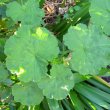
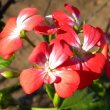
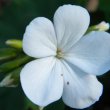

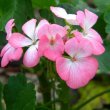
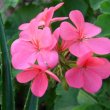

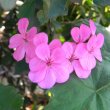


Discuss this plant
Share knowledge, ask a question or give an experience.